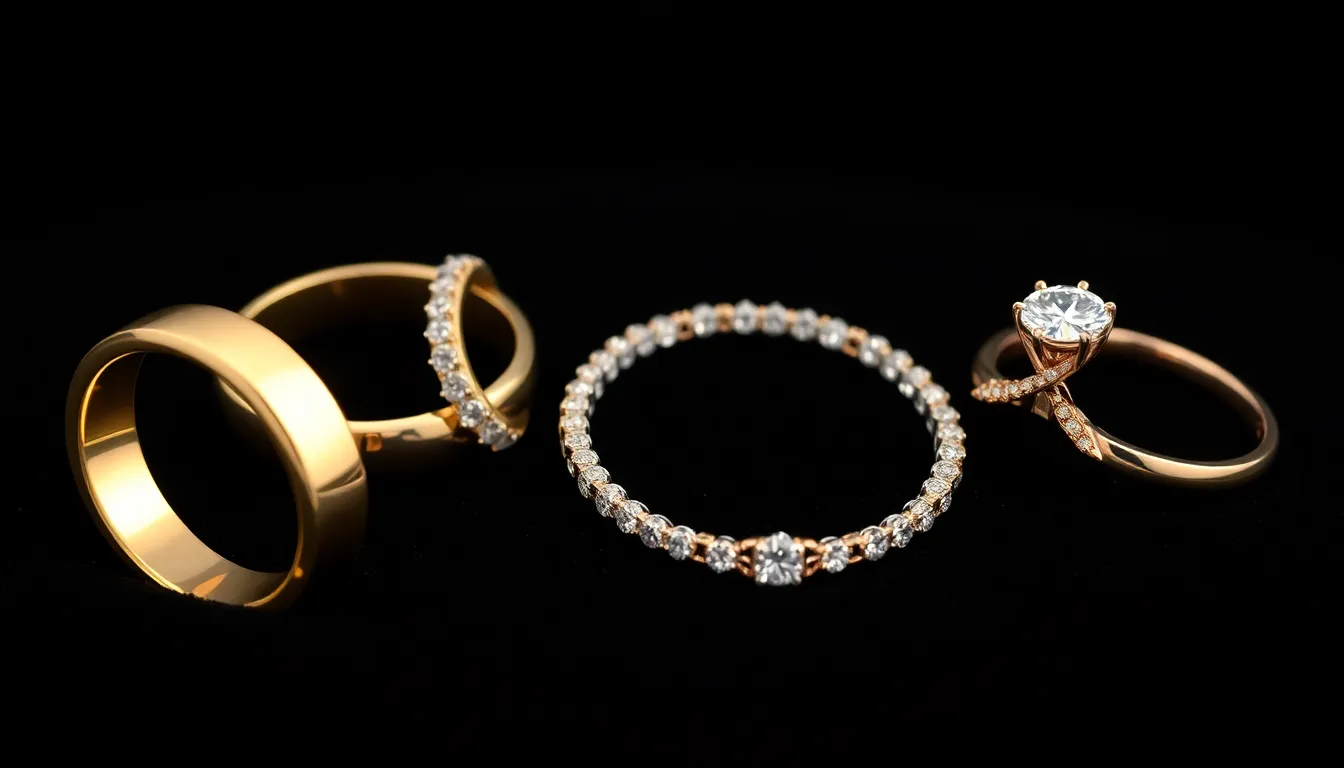Gold jewelry has long been the ultimate accessory, transforming any outfit from drab to fab in seconds. Whether it’s a dazzling pair of earrings or a sleek bracelet, gold pieces add a touch of elegance and sophistication that’s hard to resist. But let’s be honest—who doesn’t want to feel like royalty without the crown?
Beyond its beauty, gold jewelry also offers a unique blend of investment and sentiment. It’s not just about looking good; it’s about making a statement that lasts. From heirloom pieces passed down through generations to trendy designs that catch the eye, gold jewelry has something for everyone. So, let’s dive into the glittering world of gold, where style meets substance and every piece tells a story.
Table of Contents
ToggleOverview of Gold Jewelry
Gold jewelry encompasses a variety of styles including necklaces, bracelets, rings, and earrings. Each piece combines craftsmanship and artistry to create timeless designs that appeal to diverse tastes. Typically, gold’s purity is measured in karats, with 24 karat representing the highest quality. Lower karat values, such as 18 karat and 14 karat, offer durability while maintaining the luxurious appearance of gold.
Investing in gold jewelry offers both aesthetic value and financial security. Historically, gold has served as a store of wealth, often increasing in value over time. For many, gold jewelry symbolizes milestones and special moments, as it frequently marks significant life events like engagements, weddings, and anniversaries.
Gold jewelry can also reflect cultural significance. Various societies incorporate gold into traditional ornaments and ceremonial attire. In some cultures, gold jewelry serves as a means of expressing identity and heritage. These pieces often carry rich histories, making them more than mere adornments.
Maintenance plays a crucial role in preserving gold jewelry’s allure. Regular cleaning, appropriate storage, and avoiding exposure to harsh chemicals can extend the life of each piece. For instance, storing jewelry in a soft pouch minimizes scratches.
Personal stories often connect wearers to their gold pieces. A cherished family heirloom can evoke memories and foster emotional ties, adding a priceless dimension to its material value. Each piece of gold jewelry tells a unique story, allowing individuals to express their journeys through beautifully crafted designs.
Types of Gold Jewelry

Gold jewelry comes in various types, each distinguished by color and composition. The most popular types include yellow gold, white gold, and rose gold. Each type offers unique aesthetic qualities and characteristics.
Yellow Gold
Yellow gold remains a classic choice, known for its warm and rich hue. It’s made by mixing pure gold with metals like copper and zinc, which enhance durability and strength. This metal complements a wide range of skin tones, making it a versatile option. Often associated with traditional styles, yellow gold shines in wedding bands and engagement rings. Its timeless appeal ensures it remains a favorite in both contemporary and vintage collections.
White Gold
White gold features a sleek, modern look. The creation process involves alloying gold with metals such as palladium or nickel. Rhodium plating is often applied to enhance shine and protect against scratches. Jewelry designers favor white gold for its ability to resemble platinum while being more affordable. Popular pieces include earrings and bracelets, especially in elegant, minimalist designs. Its neutral tones pair well with diamonds, accentuating brilliance and clarity.
Rose Gold
Rose gold stands out for its romantic pinkish hue. Alloys of pure gold mixed with copper give this jewelry its distinct color. The warmth of rose gold enhances its fashionable appeal, attracting those seeking unique pieces. Contemporary styles frequently incorporate rose gold, making it popular in engagement rings and fashion jewelry. Its soft tones evoke a sense of charm and sophistication, appealing to diverse tastes.
The Craftsmanship Behind Gold Jewelry
Gold jewelry showcases exceptional craftsmanship that blends artistry with skill. Artisans employ various techniques to create stunning pieces, ensuring each design stands out.
Techniques Used in Making Gold Jewelry
Intricate skills define the making of gold jewelry. Casting, a common method, involves pouring molten gold into molds to create precise shapes. Hand engraving adds personal touches, allowing artisans to carve unique patterns and text. Additionally, soldering joins different elements seamlessly, enhancing the overall design. Some jewelers use filigree, creating delicate lace-like structures from thin gold strands. These diverse techniques highlight the commitment to quality and creativity in each piece.
Importance of Design
Design plays a crucial role in gold jewelry’s appeal. Innovative concepts often capture personal stories and cultural significance. Unique shapes and styles differentiate pieces, resonating with individual tastes. Timeless designs ensure that jewelry transcends trends, remaining relevant across generations. Functionality also influences design, with elements like clasps and settings enhancing usability while maintaining aesthetic value. Through thoughtful design, each piece becomes a reflection of identity, art, and heritage, emphasizing its emotional connection to the wearer.
Caring for Gold Jewelry
Caring for gold jewelry ensures its beauty and longevity. Understanding proper cleaning and storage enhances enjoyment of these treasured pieces.
Cleaning and Maintenance Tips
Regular cleaning maintains the luster of gold jewelry. Use a soft cloth to gently wipe pieces after each wear. Mild soap and warm water effectively remove dirt and oils without damaging the metal. For intricate designs, a soft-bristle toothbrush helps reach detailed areas. Avoid harsh chemicals or abrasive materials that can scratch surfaces. Engaging a professional jeweler for deep cleaning preserves the integrity of valuable pieces.
Storage Recommendations
Storing gold jewelry properly prevents scratches and tangling. Utilize a soft pouch or a dedicated jewelry box to keep items separated. Each piece benefits from being stored in individual compartments. Avoid stacking pieces, as this can lead to surface damage. Environmental factors like humidity can affect gold, so consider keeping items in a cool, dry place. Regular checks on stored jewelry ensure its condition remains pristine.
Gold jewelry stands as a testament to elegance and personal expression. Its timeless appeal transcends generations while offering both aesthetic beauty and financial value. Each piece carries a story that connects wearers to their heritage and significant life moments.
The craftsmanship and artistry behind gold jewelry ensure that it remains a cherished item in any collection. By investing in gold jewelry, individuals not only enhance their style but also secure a lasting symbol of their journey. With proper care and maintenance, these treasures can continue to shine brightly for years to come, deepening the emotional ties that make them truly priceless.


